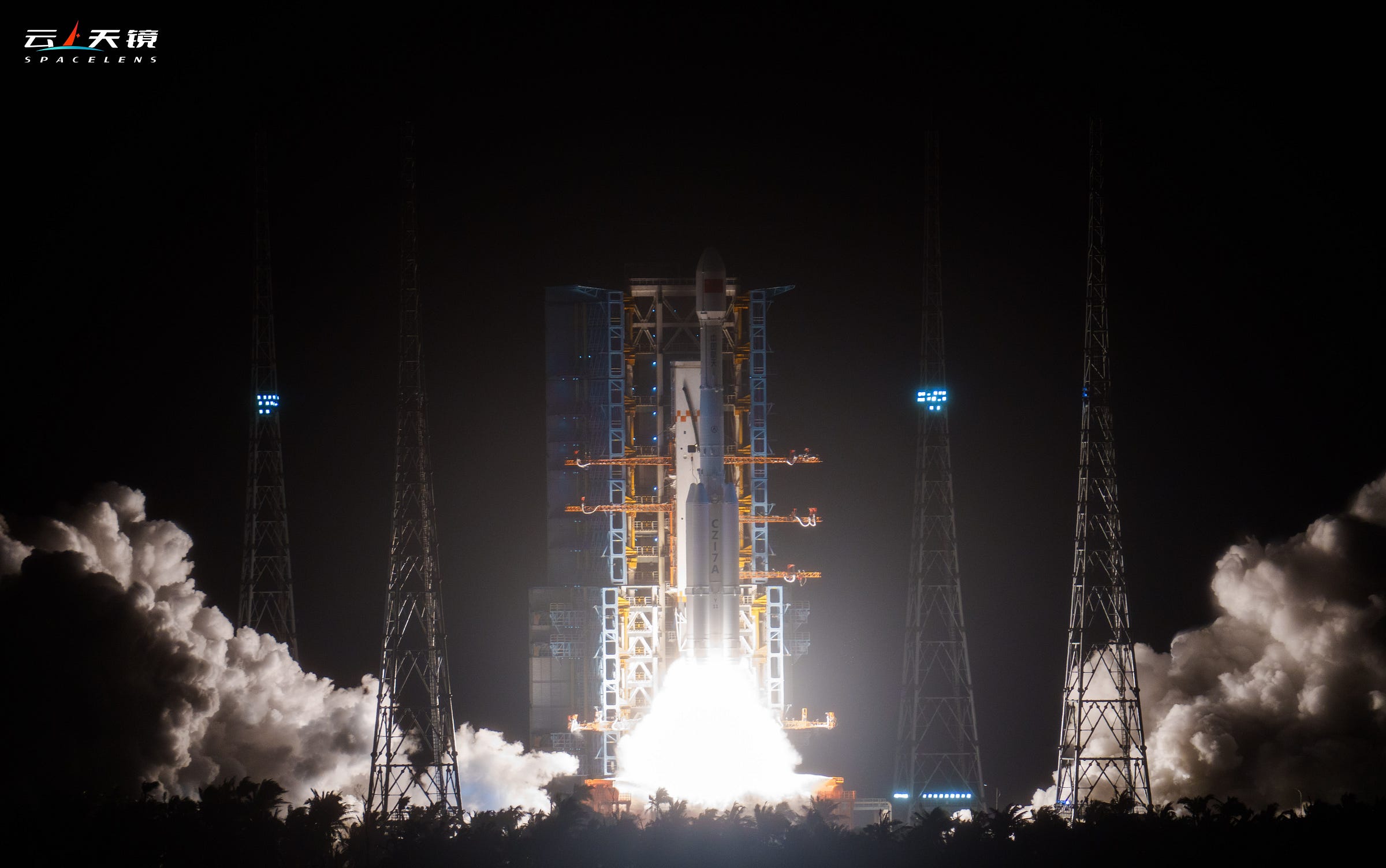TJSW Fleet Expands With Third Launch This Year [Long March 7A Y11]
A new TJSW satellite was delivered via the first Long March 7A of the year.

The Long March 7A, making its first flight of the year, blasted off from Launch Complex 201 at the Wenchang Space Launch Site at 00:05 am China Standard Time on March 30th (or 16:05 Universal Coordinated Time on March 29th). For this mission, the rocket was flying towards a geostationary transfer orbit carrying a single satellite.
Riding atop of the Long March 7A was the TJSW-16 satellite (通信技术试验卫星十六号), called Communication Technology Experimental Satellite-16 in English. Like previous TJSW spacecraft, the satellite was developed by the Shanghai Academy of Spaceflight Technology.
Uses for the satellite include communications, radio, television, and data transmission, as well as testing and verification for multi-band high-speed throughput communications technologies. So far three TJSW satellites have been launched this year, including today's.
Following the launch, the China Academy of Launch Vehicle Technology stated that the Long March 7A would fly multiple missions this year, but did not specify how many. Additionally, the low Earth orbit variant of the rocket, the Long March 7, is expected to fly at least once this year for the Tianzhou-9 cargo resupply mission to the Tiangong Space Station.
For today’s launch, the paint job on Long March 7A has seen a near-total removal of all details, like its last mission. No reason has been explicitly given for the paint job changes but is likely due to improvements in launch vehicle tracking technology no longer needing the various reference points the paint provided.
A few details left are the China Aerospace Science and Technology Corporation’s logo on the second-stage, the vehicle designation on the first-stage (CZ-7A and Y11), China Aerospace (中国航天) written on the third-stage, and of course the flag of the People’s Republic of China on the fairing.
Today’s mission was the 9th launch of a Long March 7A vehicle, the 18th launch of the Long March 7 series, and the 566th launch of the Long March launch vehicle series. This was also the 17th launch from China in 2025.
Liftoff video via 北斗_玉衡, 深柳斋, and SpaceLens云上天镜 on Weibo. Additional live stream and launch footage via International Rocket Launches on YouTube.
Check out the previous Long March 7A launch
To be secret, or not to be secret? [Long March 7A Y9]
On August 22nd, the second Long March 7A of 2024 took to the skies from LC-201 at the Wenchang Space Launch Site, located on China’s southernmost province of Hainan. Liftoff occurred at 20:25 pm China Standard Time, or 12:25 pm Universal Coordinated Time.
What is the Long March 7A?
This section is for those less familiar with China's Long March series of launch vehicles.
The Long March 7A is the new-generation workhorse for beyond low Earth orbit missions, and was developed by the China Academy of Launch Vehicle Technology. This vehicle utilizes a three-and-a-half-stage design and is fuelled by rocket-grade kerosene and liquid oxygen in its boosters, first, and second stages long with liquid hydrogen and liquid oxygen in the third-stage.
The payload capacity of the launch vehicle is currently as follows:
7,000 kilograms to geostationary transfer orbit
5,500 kilograms to a 700-kilometer sun-synchronous orbit
5,000 kilograms to a trans-lunar trajectory
The Long March 7A's first stage is equipped with two YF-100 engines that produce 245 tons of thrust using rocket-grade kerosene and liquid oxygen, complemented by four boosters, each with a YF-100 engine generating 122 tons of thrust, resulting in a combined thrust of approximately 733 tons. The second stage is powered by four YF-115 engines, which together generate 72 tons of thrust using the same fuel combination. The third stage of the Long March 7A features two YF-75 engines, providing 17 tons of thrust by burning liquid hydrogen and liquid oxygen.
On the launchpad, the Long March 7A stands at 60.13 meters tall and weighs 573,000 kilograms when fully fuelled. The first and second-stage have a diameter of 3.35 meters, the four boosters are 2.25 meters in diameter, and the third-stage has a diameter of 3 meters, while the fairing has a diameter of 4.2 meters.
So far the Long March 7A has only flown from the Wenchang Space Launch Site, on the east coast of Hainan province.






![To be secret, or not to be secret? [Long March 7A Y9]](https://substackcdn.com/image/fetch/w_1300,h_650,c_fill,f_auto,q_auto:good,fl_progressive:steep,g_auto/https%3A%2F%2Fsubstack-post-media.s3.amazonaws.com%2Fpublic%2Fimages%2Fa28117c3-ddb3-40fd-a5d9-8bd7874458da_1199x800.jpeg)
